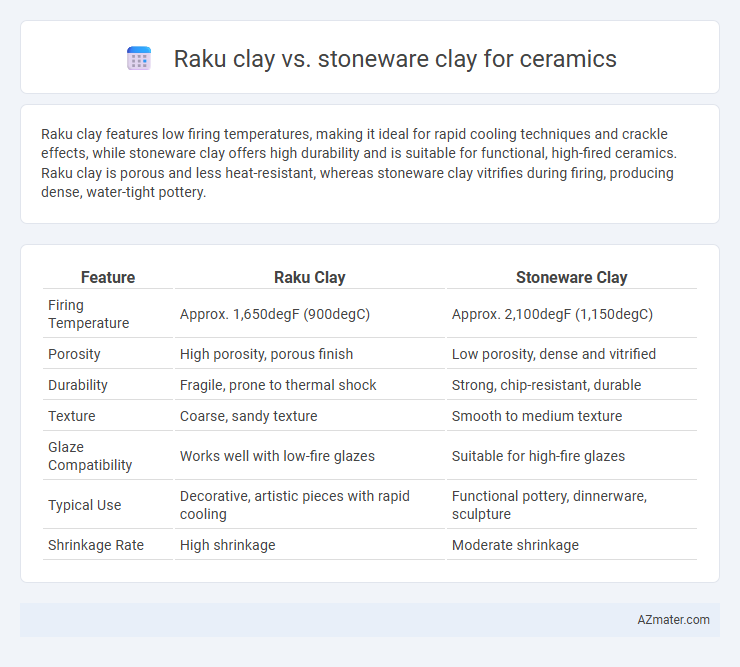Raku clay features low firing temperatures, making it ideal for rapid cooling techniques and crackle effects, while stoneware clay offers high durability and is suitable for functional, high-fired ceramics. Raku clay is porous and less heat-resistant, whereas stoneware clay vitrifies during firing, producing dense, water-tight pottery.
Table of Comparison
| Feature | Raku Clay | Stoneware Clay |
|---|---|---|
| Firing Temperature | Approx. 1,650degF (900degC) | Approx. 2,100degF (1,150degC) |
| Porosity | High porosity, porous finish | Low porosity, dense and vitrified |
| Durability | Fragile, prone to thermal shock | Strong, chip-resistant, durable |
| Texture | Coarse, sandy texture | Smooth to medium texture |
| Glaze Compatibility | Works well with low-fire glazes | Suitable for high-fire glazes |
| Typical Use | Decorative, artistic pieces with rapid cooling | Functional pottery, dinnerware, sculpture |
| Shrinkage Rate | High shrinkage | Moderate shrinkage |
Overview: Raku Clay vs Stoneware Clay
Raku clay is specially formulated to withstand rapid thermal shock during the raku firing process, making it porous and less vitrified compared to stoneware clay, which is denser and fired at higher temperatures for durability and water resistance. Stoneware clay typically matures between 1200degC and 1300degC, resulting in a stronger, more vitrified ceramic ideal for functional pottery, while raku clay fires at lower temperatures around 900degC to 1000degC and is designed for decorative, artistic pieces. The choice between raku and stoneware clay depends on intended use, firing technique, and desired surface texture, with raku offering unique crackled effects and stoneware providing robustness and longevity.
Composition and Material Differences
Raku clay typically contains a high percentage of grog and fire clay, enhancing thermal shock resistance crucial for the rapid heating and cooling process in raku firing, whereas stoneware clay features a balanced mix of kaolin, feldspar, and quartz that ensures durability and vitrification during high-temperature firing. The porous nature of raku clay allows for the absorption of smoke and oxygen during the reduction phase, producing unique surface effects, while stoneware clay's denser composition results in a more watertight, robust ceramic body. Mineral content variations drive these functional disparities, making raku clay ideal for artistic, low-fire techniques and stoneware clay suited for functional, high-fire ceramics.
Firing Temperature Requirements
Raku clay typically requires a lower firing temperature, usually between 1,650degF to 1,830degF (900degC to 1,000degC), allowing for rapid firing and cooling processes essential to the raku technique. Stoneware clay demands higher firing temperatures, ranging from 2,192degF to 2,372degF (1,200degC to 1,300degC), resulting in a denser, more vitrified ceramic body suitable for functional ware. Understanding these distinct firing ranges ensures optimal clay performance and durability in their respective ceramic applications.
Workability and Handling
Raku clay offers excellent workability due to its low firing temperature and porous nature, making it easier to manipulate and shape for intricate ceramic pieces. Stoneware clay, while denser and less porous, provides superior durability but requires more effort to work with because of its higher plasticity and firing range. Artists often prefer Raku clay for quick, hands-on projects, whereas Stoneware is favored for sturdier, long-lasting ceramics despite its tougher handling.
Surface Texture and Appearance
Raku clay typically exhibits a more porous and rough surface texture compared to stoneware clay, which is denser and smoother after firing. The rapid cooling process in Raku firing creates unpredictable crackles, metallic sheen, and smoky patterns, enhancing its unique, rustic appearance. Stoneware clay offers a durable, vitrified surface with consistent matte or glossy finishes, ideal for functional pottery requiring strength and longevity.
Glazing Compatibility
Raku clay typically has a lower firing temperature, making it compatible with specialized Raku glazes that can withstand rapid thermal shock during the post-firing reduction process. Stoneware clay is fired at higher temperatures, enabling it to pair well with a broad range of durable, high-fire glazes that vitrify the surface for increased strength and water resistance. Choosing between Raku and stoneware clay depends on the desired finish; Raku offers unique crackle effects and metallic sheens, while stoneware provides more consistent, resilient glaze surfaces.
Durability and Strength Comparison
Stoneware clay exhibits superior durability and strength compared to Raku clay, making it ideal for functional pottery that requires long-lasting wear resistance. The high firing temperature of stoneware (typically between 1200degC and 1300degC) results in a dense, vitrified body that withstands thermal shock and mechanical stress better than Raku clay. In contrast, Raku clay, fired at lower temperatures and often unglazed or crackled, is more porous and fragile, prioritizing aesthetic qualities over structural resilience.
Artistic Applications and Styles
Raku clay, known for its porous texture and thermal shock resistance, excels in producing unique, crackled finishes ideal for expressive, spontaneous ceramic art styles. Stoneware clay, denser and fired at higher temperatures, offers durability and smooth surfaces suited for functional wares and refined, detailed artistic applications. Artists often prefer raku clay for experimental glazing and rapid firing techniques, while stoneware clay supports complex sculptural forms and consistent textures in ceramic artistry.
Cost and Accessibility
Raku clay generally costs less and is more accessible due to its lower firing temperature and shorter firing cycles, making it ideal for hobbyists and small studios. Stoneware clay tends to be more expensive because it requires higher firing temperatures, specialized kilns, and longer firing times, which increases overall production costs. Accessibility to stoneware clay is often limited by the need for professional equipment, whereas raku clay is widely available and easier to handle for beginners.
Choosing the Right Clay for Your Project
Raku clay, known for its high thermal shock resistance and porous texture, suits artistic projects involving rapid firing and reduction techniques, producing unique surface effects. Stoneware clay offers durability, strength, and a dense body, ideal for functional ware requiring sturdiness and food safety. Selecting between Raku and Stoneware depends on project goals: Raku excels in decorative, experimental ceramics, while Stoneware remains the preferred choice for everyday functional items.

Infographic: Raku clay vs Stoneware clay for Ceramic
 azmater.com
azmater.com